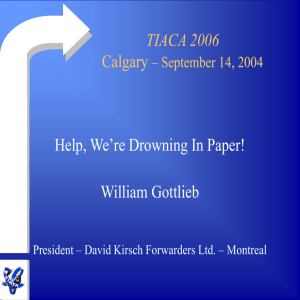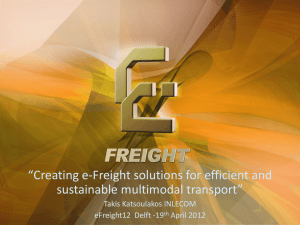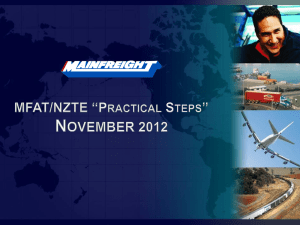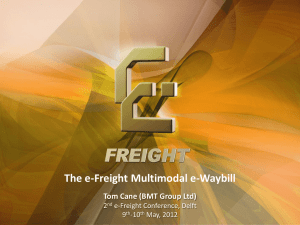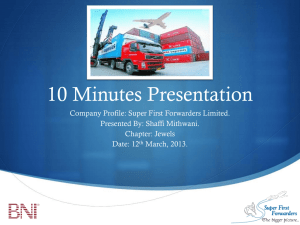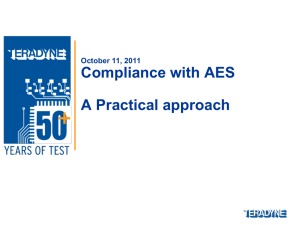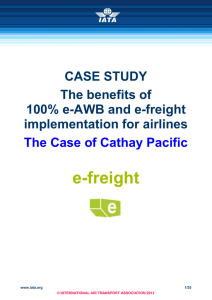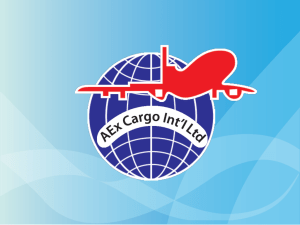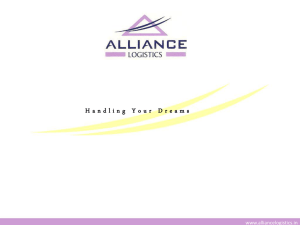e-AWB - IATA
advertisement
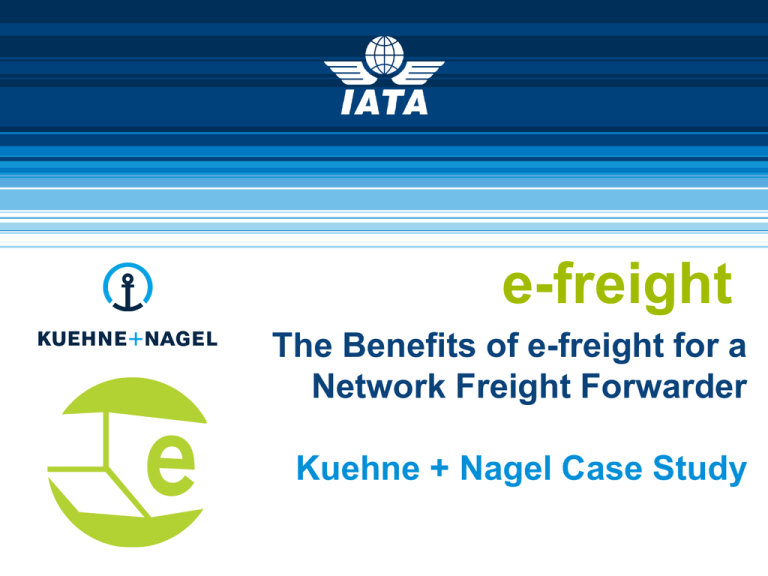
e-freight The Benefits of e-freight for a Network Freight Forwarder Kuehne + Nagel Case Study Background Air cargo supply chain stakeholders have interest in understanding how e-freight benefits can be realized In 2012, IATA published a study of benefits realized by a leading airline (Cathay Pacific) in 100% e-AWB scenario This study shows benefits for a multinational freight forwarder (Kuehne + Nagel) A final study focused on benefits for independent (SME) forwarders is to be commissioned Key findings e-freight implementation brings between 8% and 44% manpower savings for the analyzed processes of a multinational freight forwarder (Kuehne + Nagel), depending on implementation scenarios Implementation of e-AWB (with e-House Manifest) is a natural first step with cost benefits between 8% and 19% (and even higher if e-Customs and implementation of internal e-processes within the forwarder organization- i.e. e-HAWB- are factored in) Additional, non-monetary benefits include speed, quality, visibility, simplicity and regulatory compliance, making the overall case for e-freight extremely compelling GACAG roadmap to paperless In December 2012, the Global Air Cargo Advisory Group (GACAG*) published the industry Roadmap to 100% paperless with a Three-Pillar approach: Pillar I: Engaging regulators and governments worldwide to create an ‘efreight route network’ with fully electronic customs procedures and where regulations support paperless shipments Pillar II: Working collaboratively within the cargo supply chain to digitize the core industry transport documents, starting with the air waybill Pillar III: Developing a plan to digitize the commercial and special cargo documents typically accompanying airfreight today, in or outside of the ‘Cargo pouch’ For more information please visit www.GACAG.org * International Federation of Freight Forwarders Associations (FIATA), Global Shippers' Forum (GSF), International Air Transport Association (IATA), The International Air Cargo Association (TIACA) GACAG e-freight Roadmap Main constrains in paper environment Handling of paper is time consuming Freight Forwarder reduced Risk of wrong data Multiple re-capture of data Must transport both freight and paper Risk of rejection of documentation at any stage Risk of overlooking special cargo requirements Impact efficiency Potential incorrect billing by Airlines Risk of customs hold cargo and delay delivery to consignee Data capture redundancy (same data-many time) Increase of workload Extra time and space required to store and archive paper documents May lead to low customer (Consignee) satisfaction Benefits by implementing e-document procedures Cost: decrease in document processing & document transportation Speed: ability to receive and send relevant shipment information in advance of the cargo itself. This is expected to reduce the total cycle time by up to 24 hours Quality and Reliability: Electronic documents auto population – receiving the shippers data directly into the Forwarder’s system- allows one time electronic data entry at point of origin reducing and delays to shipments due to inaccurate or inconsistent data reentry Electronic documents are more easily archived and retrieved, reducing delays due to missing information Visibility: electronic documentation and processes facilitate electronic track and trace functionality and real time visibility of freight movement. Simplicity & Regulatory compliance: as supply chain stakeholders adopt electronic processes and messages, the air cargo movement will be simpler to execute and regulatory compliance will be facilitated. What are the cost benefits of e-freight for a multinational forwarder? e-freight brings benefits in export, import and archive processes Export process Receive freight and documents Sort collected documents & consolidate Import process Repatriate documents Prepare invoice & pouch Archive process Archive documents Destroy / Filing documents Prepare documents & pouch Deliver freight & documents to consignee Deliver freight only to airport Build the pouch & deliver to airport The study focuses specifically on export processes Receive freight and documents Sort collected documents & consolidate Import process Repatriate documents Prepare invoice & pouch Archive process Archive documents Destroy / Filing documents Export process Prepare documents & pouch Deliver freight only to airport Deliver freight & documents to consignee Build the pouch & deliver to airport FOCUS OF THIS CASE STUDY Not analyzed in detail (due to time/resource constraints), however expected to yield comparable benefits to export process Benefits of e-Archiving already analyzed in previous case study (see www.iata.org/e-freight) For forwarders, benefits come from data integration with key partners Shipper-Forwarder integration: electronic Commercial invoice and electronic Packing List between Shipper and forwarder at origin Airline- Ground HandlerForwarder integration: electronic AWB and electronic House manifest between airline forwarder and ground handler at origin Forwarder-Forwarder integration: integration between origin forwarder and destination forwarder, materialized by the removal of the document pouch traditionally accompanying the freight e-freight leads to elimination or reduction of tasks from paper process e-freight benefits for a Multinational Forwarder – Kuehne + Nagel HKG case Benefits (i.e. labour hours saved) range from 8% to 44% depending on implementation scenario * Includes 14 % from Shipper integration and 6% from e-Pouch **Includes 14% from Shipper integration and 12% from e-Pouch Additional benefits Other cost and time savings Improved customer service and quality Sustainable development Saved time for tracking shipment status Reduce storage cost by eliminating paper document and free up valuable office space Eliminate costs of paper destruction and recycling in e-freight environment Save cost of blank paper air waybills and house air waybills Fewer lost documents Less discrepancies due to missing documents Better shipper asset protection due to reduced information access Better handling of urgent shipments Reduced end-to-end transit times Faster answer to customer via digital information Faster, more reliable customs clearance and goods delivery Supply chain partners Communicate using standard Electronic Data Interchange regulations Eco- friendly Boost company status in the community by helping part of green revolution Conclusion e-freight implementation brings between 8% and 44% manpower savings for the analyzed processes of a multinational freight forwarder (Kuehne + Nagel), depending on implementation scenarios Implementation of e-AWB (with e-House Manifest) is a natural first step with cost benefits between 8% and 19% (and higher if e-Customs and implementation of internal e-processes within the forwarder organization- i.e. e-HAWB- are factored in) Additional, non-monetary benefits include speed, quality, visibility, simplicity and regulatory compliance, making the overall case for e-freight even more compelling What made this implementation possible? Favorable regulatory Environment (e-Customs procedures in place) Process optimization e-freight Investment in Technology* Stakeholder involvement *Includes implementation of paperless process within the forwarder organization, i.e. internal e-House Air Waybill (e-HAWB) process Appendix 1: History of e-freight program • In 2005 and 2006 e-freight program feasibility and scoping studies were carried out • In 2007 and 2008 pilots were conducted. • In 2009 and 2011 an initial network of e-freight routes was developed and standards supporting the defined business process were created • In 2012, IATA worked with its partners in the Global Air Cargo Advisory Group (GACAG), to develop an industry roadmap to achieve the vision of paperless air cargo transportation. The roadmap was formally endorsed by all GACAG members and published in December 2012. Appendix 2: Pre-Requisites for e-freight implementation by a forwarder There are two important additional components to be considered while implementing paperless procedures: e-House Airway Bill (e-HAWB): the ability of a forwarder to exchange internal documents electronically. The case study assumes that the forwarder, when implementing e-freight with its airline, GHA and shipper partners, has already implemented internal paperless procedures (e-HAWB). e-Customs procedures: the ability to perform electronic customs declarations and get electronic release. In the case of Hong-Kong, electronic procedures existed before the implementation of the other e-freight components . The case study focuses solely on the impact of non-customs components. For a freight forwarder without internal paperless procedure and for a location without e-customs procedure in place, the total case for e-freight is even more compelling. e-freight: Find out more Tools provided by IATA to support you: e-Cargo Matchmaker: who does e-freight where e-freight complete Case Studies e-freight Handbook: implementation guide e-freight self-assessment questionnaire e-freight Model EDI agreement (for e-AWB) Capability Matrix of IT Providers www.iata.org/e-freight and www.iata.org/e-AWB
